#1st half 3rd century
Explore tagged Tumblr posts
Text
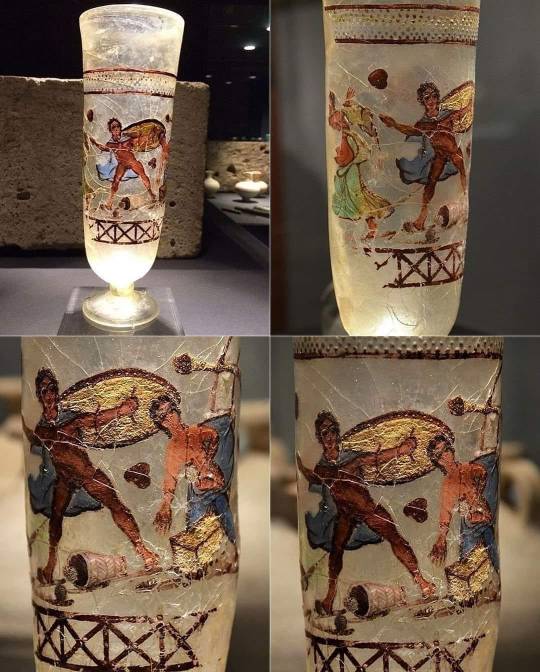
Achilles goblet made of colourless glass with polychrome painting. Height 24.5 cm. 1st half of the 3rd century AD, was found at Richard-Wagner-Strasse 47, in 1991 in Cologne, Germany The color of the brilliant paint was as fresh as if it had just been applied. The scene painted on glass depicts the "unveiling" of Achilles on Skyros Island. Odysseus managed to find and expose Achilles, who was hidden among daughters of King Lycomedes on Skyros Island. He then took him to the war against Troy, where Achilles was no longer expected to have a peaceful marriage with Déidameia.
35 notes
·
View notes
Text
Talking about alnst to my irl friends that aren't into these niche things is so funny bc I have to water down everything to keep them engaged
I'd say something like: So, humanity has been overthrown by aliens and now they have to compete in this sort of The Voice - deadly edition where if you lose they fucking shot you live in 4k. In the 1st ep the protag's (Mizi) gf (Sua) trows the round on purpose and fucking dies in front of her. In the second ep the rebellious dude (Till) that has a crush on the protag get's introduced, and in the 3rd one his best friend (Ivan) that has low key feelings for him debuts. In the 5th round, round 4 happens off screen, our dear protag is a little depressed but she has to go against the asshole still victim of this society (Luka) that pulls some mind tricks and tries to seduce her impersonating her dead gf to win the round, at that our protag snaps and beats the shit out of him therefore she loses, but worry not, bc she was rescued by the human rebellion. There we have this badass (Hyuna) that has a shared history with the asshole victim of this society, and with her protag has to go back to The Voice - deadly edition for a mission. In the next round rebellious dude is a little depressed bc protag is missing and he has to go against his best friend that trows the round and dies in front of him (where did I ear that before), while the rebellion is discovered by the aliens. FINAL ROUND, Rebellious dude vs Asshole victim of this society GO! The rebellious dude get emotionally tortured by the asshole victim of this society that is pulling the same trick again impersonating his dead best friend while the rebellion tries to do what they can. The protag goes to the rebellious dude rescue, and the moment he reaches for her, he fucking dies and as she's crying the loss of her last childhood friend, in background, there's the reunion of the century between the asshole victim of this society and the badass. The end :)
And all this while not mentioning the gayest shit, like how half of the cast is gay as hell, Hyuna is lowkey bi and that when the two "straightest" characters went against each other the performance certainly wasn't the straightest one (that's R2), the fact that R3 is THE Gay Yearning anthem, the whole R1 dialogue and the shit that Ivan pulled in R6
#in my first language it was funnier#alnst#alien stage#mizi alnst#mizi alien stage#alien stage mizi#alnst mizi#sua alnst#sua alien stage#alnst sua#alien stage sua#alnst till#till alien stage#till alnst#alien stage till#alnst ivan#ivan alien stage#ivan alnst#alien stage ivan#luka alnst#luka alien stage#alien stage luka#alnst luka#hyuna alnst#hyuna alien stage#alnst hyuna#alien stage hyuna
109 notes
·
View notes
Text
I don't bring up politics and world events up on here very much, that isn't what this blog is about. This blog is for escapism from reality, but those who are not willing to speak out against brutality are complicit. And this is my largest platform.
Don't continue reading if you don't want to read about war and violence.
Regarding Israel and Palestine I have seen many inaccurate assumptions and outright lies.
1ST CLAIM: One claim I hear ad nauseum is that Gaza elected Hamas and therefore they deserve punishment.
Let's break this down.
A. Hamas was elected around 2006. 17 years ago. They have not allowed elections since.
B. Roughly half of the Gazan population are under 18. This means half the population wasn't born during the last election. This means that of the Gazans who were alive many were too young to vote.
C. Hamas won by a 45 percent plurality, not a majority. This means that less than half of the Gazan who did vote did so for Hamas.
So taking these facts together we can conclude that only a fraction of a fraction of Gazans alive today elected Hamas.
In fact Netanyahu was happy to fund and prop up Hamas because doing so meant dividing Palestinians between the Palestinian Authority in the West Bank and Hamas in Gaza. So Netanyahu is more to blame for Hamas than Palestinians are.
2ND CLAIM: Another thing I hear a lot is that this conflict and all of the casualties are the fault of Hamas. Let me be clear, I do not support Hamas or the October 7th attack that ended up with a civilian casualty rate of around 50 percent, but that one attack doesn't exist alone or without context and nuance as many on the pro-Israel side would have people believe.
No, that attack was one incident in a line of many. Starting with the brutal apartheid, displacement, and ethnic cleansing of Palestinians by Israel.
A slow motion genocide taking place over the course of many decades.
Let's look at some events leading up to and then following Oct. 7th.
It starts with the beginning of Israel. Even the often recited phrase "a land without people for a people without land" erases the existence of native people who had lived there for centuries.
In 1948 you have The Nakba. A mass displacement of Palestinians as Israel took their land. This flew in the face of the UN partition plan, after The Nakba Israel controlled 78 percent of the land, 25 percent more than the UN plan.
This trend of land theft has only continued.
Let's fast forward to more recent events.
2018-2019 The Great March of Return: For over a year there were peaceful marches protesting the Gaza border, this resulted in Israeli forces killing over 220 peaceful Palestinian protesters.
In 2019 Netanyahu admitted support for Hamas to prevent a 2 state solution.
In 2022 journalist Shireen Abu Akleh was targeted and killed by Israeli forces. Israeli forces also attacked her funeral.
Note that during this entire time Palestinians are arrested, even children, and kept in indefinite detention without trial.
In 2023 we then have the October 7th attack. But as you are now aware this isn't where the conflict started.
And clearly not where it has ended.
3RD CLAIM: And that brings us to the 3rd and most blatantly bullshit lie you will here on repeat. The notion that Israel only targets Hamas.
More UN workers have been killed in a 2 month period than have died in any other war since the UN's formation. Over 130.
If they were targeting Hamas then why have so many UN buildings, refugee camps, and hospitals been bombed?
If there goal wasn't civilians then why do civilians make up the majority of the casualities?
Why the medieval style siege/blockade that has caused hospitals to lose fuel and medicine and civilians to go hungry and thirsty?
Why parade civilians around in their underwear? Why laugh and cheer as a UN school is exploded?
Why leave babies in the NICU and force the hospital staff to leave with the promise an ambulance would be provided for the babies only for people to return once the IDF left and find the baby corpses rotting because the ambulance was never provided?
We can even leave Gaza to prove this is not about Hamas. Hamas does not lead the West Bank. And yet Palestinians there are being murdered and arrested at increased rates, their homes stolen by illegal settlers.
Israel officials have called this the Gaza Nakba, they have claimed they will make Gaza inhospitable, they have claimed there are no civilians in Gaza.
Netanyahu has said to remember Amalek.
What is Amalek? Amalek refers to Israels enemy in the bible. This phrase specifically, "Now go, attack the Amalekites and totally destroy all that belongs to them. Do not spare them; put to death men and women, children and infants, cattle and sheep, camels and donkeys"
Israel wants to steal the little land the Palestinians have left. Even now they are herded and concentrated into ever smaller camps with no resources.
Idk what we can do about the situation. This post seems silly for all the good it will do. But maybe it will open the eyes of a couple people. I think that would make it worth it.
289 notes
·
View notes
Text
Pink is for Boys
"Pink or Blue? Which is intended for boys and which for girls? This question comes from one of our readers this month, and the discussion may be of interest to others. There has been a great diversity of opinion on this subject, but the generally accepted rule is pink for the boy and blue for the girl. The reason is that pink, being a more decided and stronger color, is more suitable for the boy, while blue, which is more delicate and dainty, is prettier for the girl." ~ The Infants' Department, June 1918

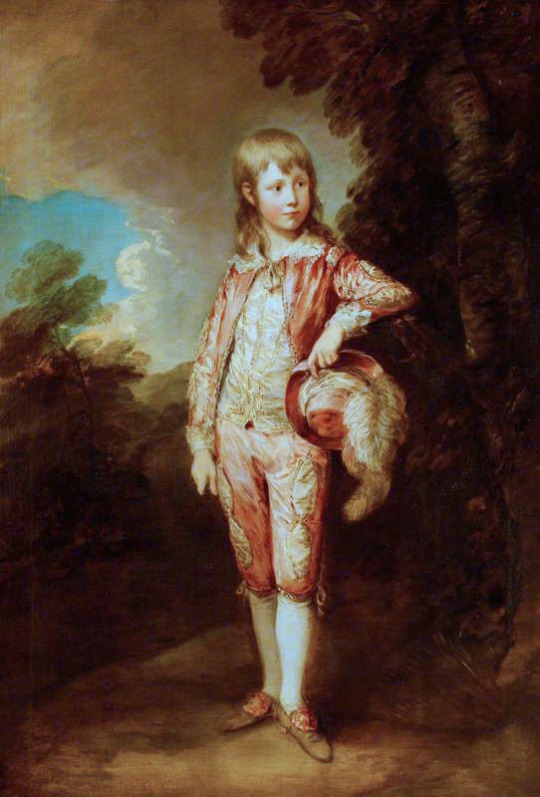
[Left: The Blue Boy, oil on canvas, c. 1770, by Thomas Gainsborough.
Right: The Pink Boy, oil on canvas, c. 1782, by Thomas Gainsborough.]
Pink is for girls and blue is for boys. But it hasn't always been this way. Colour coding infants as a way of denoting gender was popular in 20th century America. The problem? Pink and blue? Which is for boys and which is for girls?
In 1927 TIME Magazine asked ten of the "leading stores that sell baby equipment" which colour was for which gender. Four stores responded pink for girls and blue for boys; Macy's (Manhattan), Franklin Simon (Manhattan), Wanamaker's (Philadelphia) and Bullock's (Los Angeles). Five stores responded pink for boys and blue for girls; Best's (Manhattan), Marshall Field's (Chicago), Filene's (Boston), Maison Blanche (New Orleans) and The White House (San Francisco). Curiously Halle's (Cleveland) responded that pink was for both boys and girls.
This debate would continue and it wasn't until mid-20th century that pink for girls and blue for boys became firmly cemented in western culture.
However the idea of colour coding infants dates back to the 19th century. According to La cour de Hollande sous le règne de Louis Bonaparte in 1808 in Holland pink was used to announce the birth of a girl and blue a boy. In March 1856 Peterson's Magazine (Philadelphia, USA) advises that the ribbon on a christening cap should be blue for a boy and pink for a girl. On the 23rd of July 1893 the New York Times writes that for baby clothes it's "pink for a boy and blue for a girl!"

[The Oddie Children, oil on canvas, c. 1789, by William Beechey, via North Carolina Museum of Art.]
During the latter half of the 18th century one of the most popular outfits for young children, regardless of gender, was a white dress with a coloured sash tied around the waist. Pink and blue being the most popular colours, although other colours were worn as well. It would be tempting to assume that the colour of the sash indicated gender but there isn't clear evidence that this was the case. The Oddie Children (above) depicts Sarah, Henry, Catherine, and Jane Oddie. The three girls are all wearing white dresses; two with a blue sash one with a pink sash. We also see Henry Russell (bellow left) wearing a blue sash and Prince William (bellow right) wearing a pink sash.
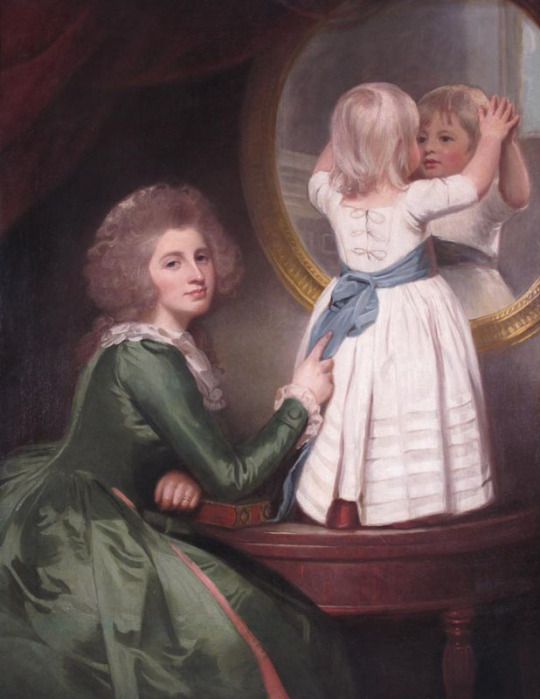
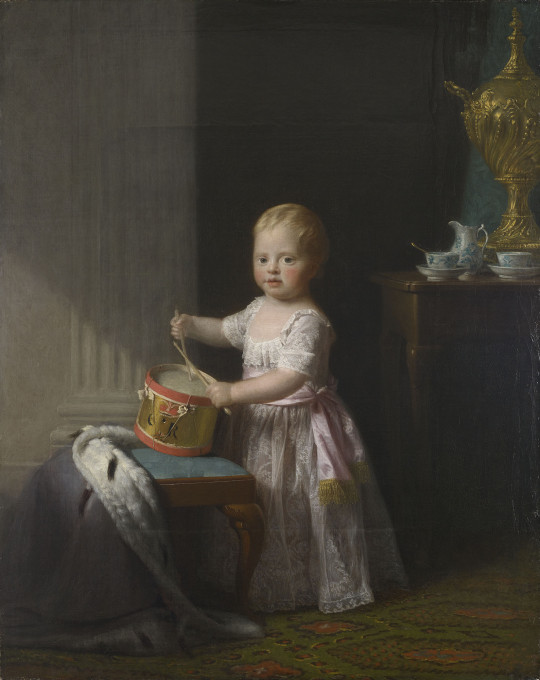
[Left: Anne Barbara Russell née Whitworth with her son Sir Henry Russell, oil on canvas, c. 1786, by George Romney, via Woolley & Wallis.
Right: Prince William, oil on canvas, c. 1767, by Allan Ramsay, via the Royal Collection Trust.]
Pink was just one of the many colours popular in 18th century English womenswear and seems to have stayed popular throughout the century. On the 3rd of January 1712 The Spectator published an article in which a man recalls seeing "a little Cluster of Women sitting together in the prettiest coloured Hoods that I ever saw. One of them was Blew, another Yellow, and another Philomot; the fourth was of a Pink Colour, and the fifth of a pale Green". On the 1st of May 1736 the Read's Weekly Journal, or British Gazetteer reports that the ladies attending the royal wedding wore gowns of "Gold stuffs, or rich Silks with Gold or Silver Flowers, or Pink or White Silks, with either Gold or Silver Netts or Trimmings;" shoes either "Pink, White or Green Silk, with Gold or Silver Lace and braid all over." On the 24th of May 1785 Charles Storer writes to Abigail Adams advising that fashionable colours in English court dress are "pink, lilac, and blue" such "as is worn at Versailles".
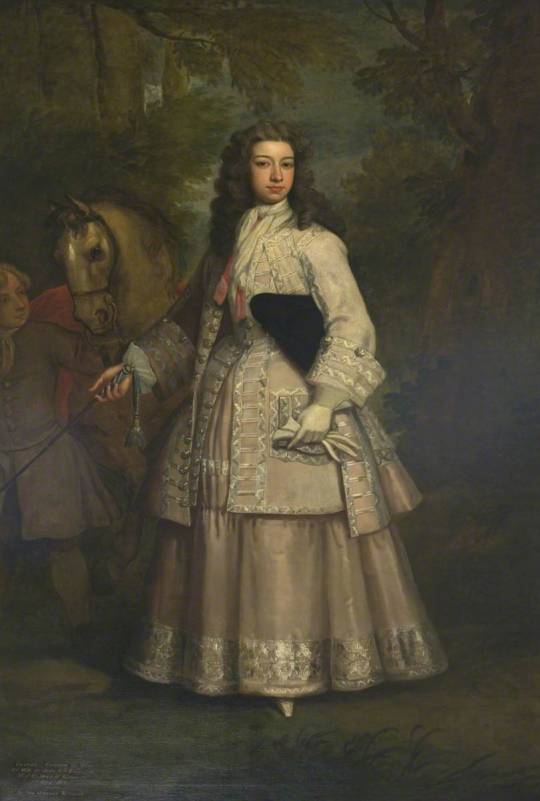
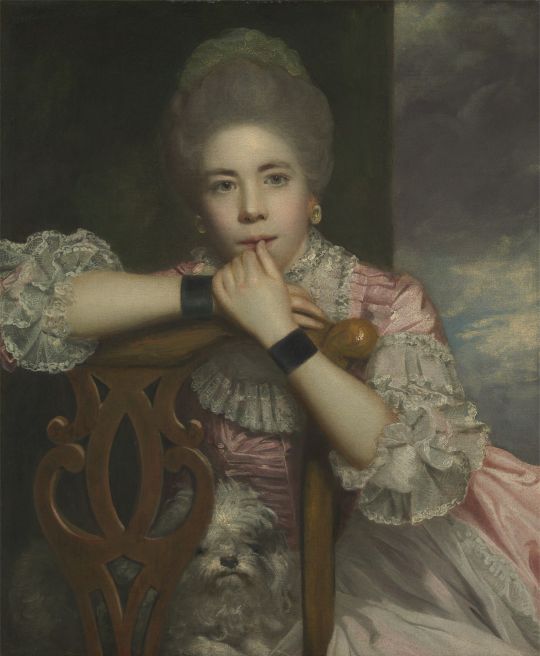
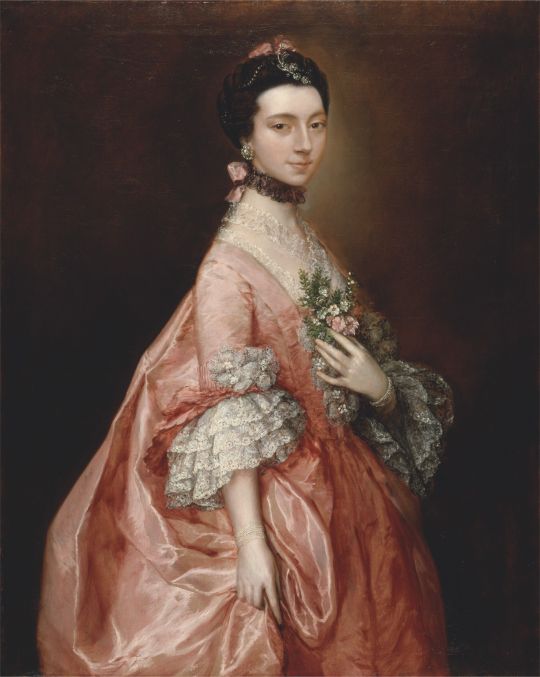
[Left: Frances, Daughter of Evelyn Pierpont, 1st Duke of Kingston, oil on canvas, c. 1700-23, by Godfrey Kneller, via Art UK.
Middle: Mrs. Abington as Miss Prue in "Love for Love" by William Congreve, oil on canvas, c. 1771, by Sir Joshua Reynolds, via Yale Center for British Art.
Right: Mary Little, later Lady Carr, oil on canvas, c. 1765, by Thomas Gainsborough, via Yale Center for British Art.]
In particular pink was popular amongst young women as the colour was associated with youth. Older women who wore pink were mocked as vain for dressing in a way that was seen as improper for their age. On the 31st of January 1754 Lady Jane Coke writes to Mrs. Eyre criticising old women who wear pink:
As for fashions in dress, which you sometimes inquire after, they are too various to describe. One thing is new, which is, there is not such a thing as a decent old woman left, everybody curls their hair, shews their neck, and wears pink, but your humble servant. People who have covered their heads for forty years now leave off their caps and think it becomes them, in short we try to out-do our patterns, the French, in every ridiculous vanity.
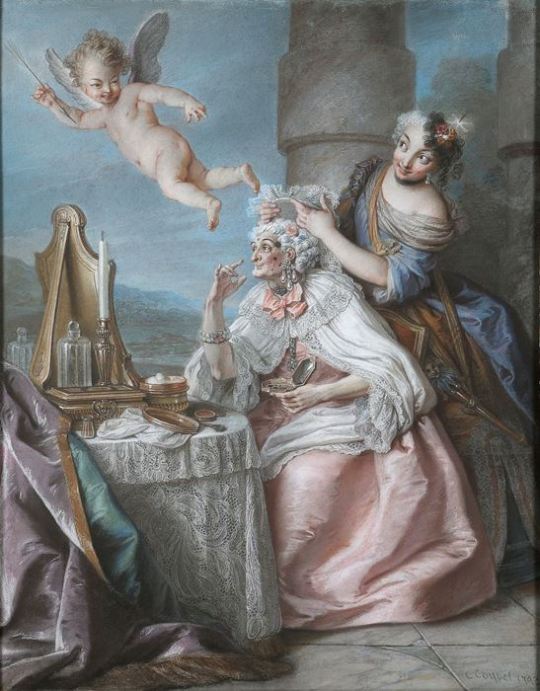
[Folly Embellishing Old Age With the Adornments of Youth, oil on canvas, c. 1743, by Charles-Antoine Coypel, via Master Art.]
For Englishmen acceptable clothing way much more limited. In A Foreign View of England in the Reigns of George I & George II Monsieur César de Saussure writes that Englishmen "do not trouble themselves about dress, but leave that to their womenfolk". He explains:
Englishmen are usually very plainly dressed, they scarcely ever wear gold on their clothes; they wear little coats called "frocks," without facings and without pleats, with a short cape above. Almost all wear small, round wigs, plain hats, and carry canes in their hands, but no swords. Their cloth and linen are of the best and finest. You will see rich merchants and gentlemen thus dressed, and sometimes even noblemen of high rank, especially in the morning, walking through the filthy and muddy streets.
César de Saussure warns that "a well-dressed person in the streets, especially if he is wearing a braided coat, a plume in his hat, or his hair tied in a bow, he will, without doubt, be called "French dog" twenty times perhaps before he reaches his destination" and is not only at risk of "being jeered at" but also "being bespattered with mud, but as likely as not dead dogs and cats will be thrown at him."
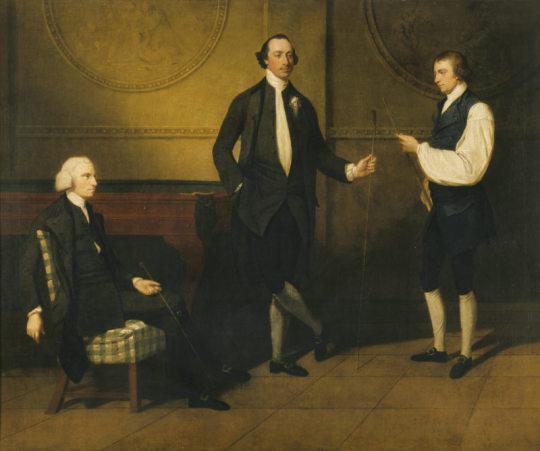
[Reverend Charles Everard Booth, Captain Griffith Booth, and an Unidentified Man playing Billiards, oil on canvas, c. 1775-9, by John Hamilton Mortimer, via the Royal Collection Trust.]
For Englishmen dressing "plainly" mostly meant wearing blacks and browns. In his book on macaroni, Pretty Gentleman, Peter McNeil found that in contrast most English menswear that he describes as generally consisting of "monochrome broadcloth" macaroni wore a variety of colours including green, orange, yellow, violet, red, white, blue, gold, silver and of course pink.
But it's not just the macaroni of the 1770s & 1780s that wore pink. We see pink in descriptions of feminine men's dress (both real and fictional) throughout the 18th century.
On the 2nd of June 1722 Sarah Osborn writes to Robert Byng:
I believe the gentlemen will wear petticoats very soon, for many of their coats were like our mantuas. Lord Essex had a silver tissue coat, and pink color lutestring waistcoat, and several had pink color and pale blue paduasoy coats, which looked prodigiously effeminate.
On the 18th of October 1729 the Universal Spectator and Weekly Journal published a story where an "effeminate" man's clothes were described as follows:
He had a flower'd pink-colour Silk Coat, with a Green-Sattin Waistcoat lac'd with Silver. Velvet Breeches, Clock'd Stockings the Colour of his Coat, Red-heel'd Pumps, a Blue Ribbon at the Collar of his Shirt, and his Sword-Hilt he embrac'd under the Elbow of his Left Arm,

[Sir Miles Stapylton, 4th Bt of Myton, oil on canvas, c. 1730-35, via Art UK.]
In The Adventures of Roderick Random (1748) the effeminate (and queer coded) Captain Whiffle is described as follows:
our new commander came on board in a ten-oared barge, overshadowed with a vast umbrella, and appeared in everything the reverse of Oakum, being a tall, thin young man, dressed in this manner: a white hat, garnished with a red feather, adorned his head, from whence his hair flowed upon his shoulders, in ringlets tied behind with a ribbon. His coat, consisting of pink-coloured silk, lined with white, by the elegance of the cut retired backward, as it were, to discover a white satin waistcoat embroidered with gold, unbuttoned at the upper part to display a brooch set with garnets, that glittered in the breast of his shirt, which was of the finest cambric, edged with right Mechlin: the knees of his crimson velvet breeches scarce descended so low as to meet his silk stockings, which rose without spot or wrinkle on his meagre legs, from shoes of blue Meroquin, studded with diamond buckles that flamed forth rivals to the sun! A steel-hilted sword, inlaid with gold, and decked with a knot of ribbon which fell down in a rich tassel, equipped his side; and an amber-headed cane hung dangling from his wrist. But the most remarkable parts of his furniture were, a mask on his face, and white gloves on his hands, which did not seem to be put on with an intention to be pulled off occasionally, but were fixed with a curious ring on the little finger of each hand.

[Henry Ingram, 7th Viscount Irwin and His Wife Anne, oil on canvas, c. 1745, by Philippe Mercier, via Art UK.]
On the 28th of July 1780 the London Courant reports:
A few days ago, a Macaroni made his appearance in the Assembly-room at Whitehaven, in the Following dress: a mixed silk coat, pink sattin waistcoat and breeches, covered with an elegant silver nett, white silk stockings with pink clocks, pink sattin shoes and large pearl buckles, a mushroom coloured stock, covered with a fine point lace; his hair dressed remarkably high, and stuck full of pearl pins.
On the 6th of August 1792 The Weekly Entertainer published Sketches and Portraits form the Life by Simon Tueopnrastus which included the following description:
Mercator was a youth of some genius and expectation, but by a strange perverseness of disposition, notwithstanding the extreme natural stiffness of his limbs, he had acquired an early attachment to the most finical and effeminate finery; so that, while yet a boy, he would exhaust every expedient of a fertile invention to procure a laced waistcoat, or the most foppish toy; would dangle a watch-string, with brass seals, from each fob, at a time when the frugal care of his parents would not permit him to wear a watch in either; and would strut in a fine pair of second-hand pink silk breeches, and a light blue coat, with all the formal dignity of—a soldier upon the parade.


[Left: Thomas King in "The Clandestine Marriage", oil on canvas, c. 1792, by Samuel De Wilde, via Yale Center for British Art.
Right: Edward Payne, oil on canvas, by Arthur Devis, via Art UK.]
While pink is mentioned in these descriptions of feminine men's dress it's not singled out as the girl colour the way pink would become in the 20th century. I would argue pink is seen as effeminate not because pink is a uniquely feminine colour but because it was used in fashionable dress. In 18th century England being interested in fashion was seen as an frivolous female trait. Men who showed too much interest in fashion were mocked and ridiculed for their gender nonconformity. "A Man must sink below the Dignity of his Nature, before he can suffer his Thoughts to be taken up on so trivial an Affair, as the Chosing, Suiting, and Adjusting the Adornments of his Person," complains a letter published on the 8th of May 1731 in Read's Weekly Journal, or British Gazetteer:
Decency of Garb ought inviolably to be preserved; nor can there be possibly an Excuse for Dressing like a Merry-Andrew: Rich and coloured Silks are in themselves effeminate, and unbecoming a Man; as are, in short, all Things that discover Dress to have been his Study 'Tis in vain for a Fop of Quality, to think his Title will protect him.


[Left: Madame de Pompadour (detail), oil on canvas, c. 1756, by François Boucher, via Alte Pinakothek.
Right: Elizabeth Wrottesley, later Duchess of Grafton, oil on canvas, c. 1764-5, by Thomas Gainsborough, via National Gallery of Victoria.]
English fashion was highly influenced by French fashion. A popular colour scheme in French fashion was green and pink. A famous example of this colour pairing can be seen in François Boucher's portrait of Madame de Pompadour (above left), she is depicted in a green gown with pink bows and flowers. You can see and example of how this style inspired English fashion in Thomas Gainsborough's portrait of Elizabeth Wrottesley (above right), who is depicted in a green gown with a floral pattern adorned with pink, white and green striped bows.
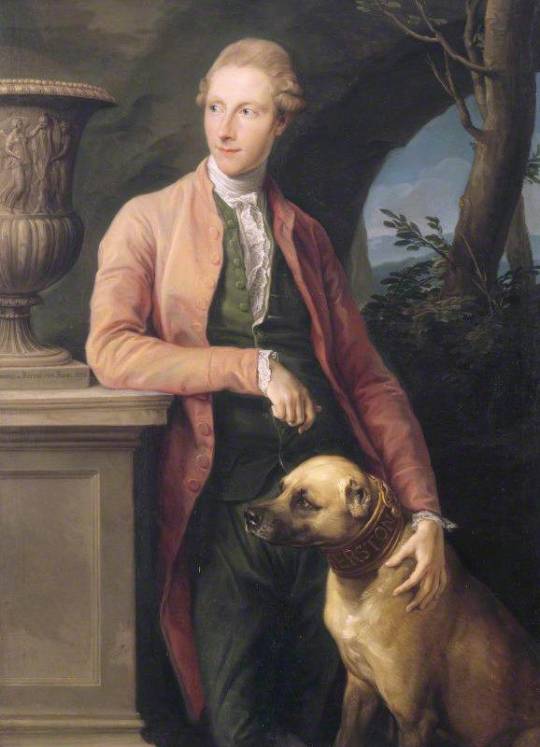
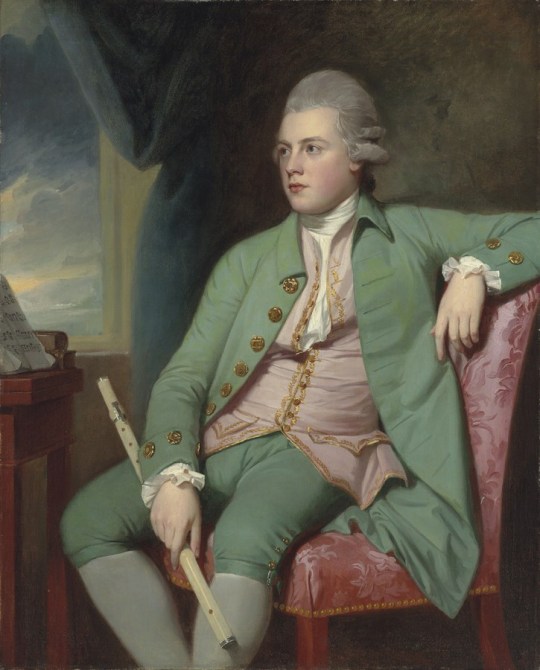
[Left: Sir Harry Fetherstonhaugh, oil on canvas, c. 1776, by Pompeo Batoni, via Wikimedia.
Right: Francis Lind, oil on canvas, c. 1775, by George Romney, via Mackinnon Fine Art.]
Fashionable Englishmen were also inspired by these French designs. Horace Walpole refers to the popularity of the colour combination writing to Lady Ossory on the 19th of February 1774 "If I went to Almack's and decked out my wrinkles in pink and green like Lord Harrington, I might still be in vogue". Almack's is referring to Almack's Assembly Rooms on Pall Mall which is believed to be the inspiration for the Macaroni Club. (see Pretty Gentleman by Petter McNeil p52-55) In a letter to Lord Harcourt on the 27th of July 1773 Walpole writes of "Macaronis lolling out of windows at Almack's like carpets to be dusted."
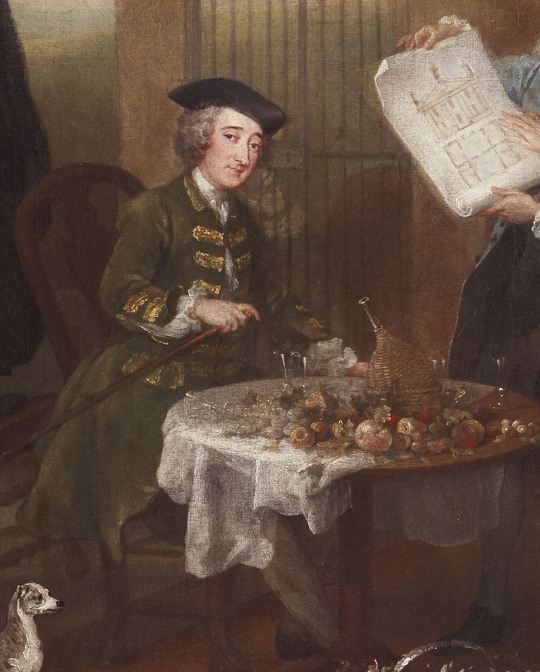

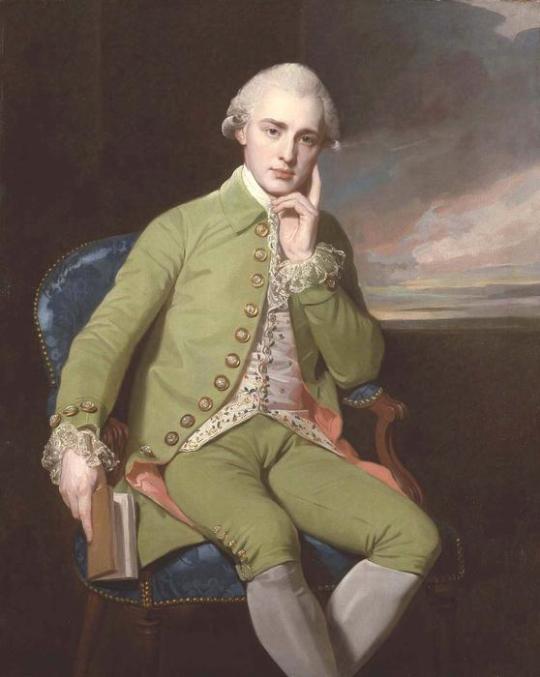
[Left: Detail of Stephen Fox from The Hervey Conversation Piece, oil on canvas, c. 1738-40, by William Hogarth, via Fairfax House.
Middle: Sir William Jones, oil on canvas, c. 1769, by Francis Cotes, via Art UK.
Right: Portrait of a Gentleman, oil on canvas, by George Romney.]
Men who wore green seem to have been just as much, if not more, at risk of being ridiculed, or even assaulted, for the colour of their clothes as those who wore pink. In Pierre Jean Grosley's A Tour to London (originally published 1772) he recalls traveling with a young English surgeon who was harassed by Londoners due to his green French frock coat:
At the first visit which he paid me in London, he informed me, that, a few days after his arrival, happening to take a walk thro' the fields on the Surry side of the Thames, dressed in a little green frock, which he had brought from Paris, he was attacked by three of those gentlemen of the mobility, who, taking him for a Frenchman, not only abused him with the foulest language, but gave him two or three slaps on the face: "Luckily, added he in French, I did not return their ill language; for, if I had, they would certainly have thrown me into the Thames, as they assured me they would, as soon as they perceived I was an Englishman, if I ever happened to come in their way again, in my Paris dress."
244 notes
·
View notes
Text

Roman Painted Goblet (3rd Century AD) found in 1991 in Cologne, Germany.
Photography: Carole Raddato
1st half of the 3rd c.AD Achilles goblet made of colourless glass with polychrome painting. Achilles on Skyros cup, H.24.5 cm. Romano-Germanic Museum, Cologne.
111 notes
·
View notes
Text




Here's an interesting question: why has western feminism failed so much at achieving gender equality in STEM careers, meanwhile Iran and many other Muslim countries that are considered to be repressive to women's rights have been so successful at it?
Communist countries of the 20th century were also very successful at getting women into STEM careers, which is why even to this day, after the fall of communism in those countries, roughly half of scientists in Russia and Eastern European countries are women, so this isn't just a Muslim thing. It seems that liberal feminism has failed at getting women into STEM careers, especially in areas like engineering which is a total sausage fest.
Also, this is a good counterpoint to the Jordan Peterson/James Damore argument of women supposedly just being innately less interested in STEM careers because of their biology or whatever.
Clearly that's not the case since many countries around the world have already achieved gender equality in STEM careers, so this is really just a failure of the liberal west, not a result of women's innate biology like the Jordan Petersons and James Damores of the world suggest.
Sources:
1st slide: https://www.forbes.com/sites/amyguttman/
2015/12/09/set-to-take-over-tech-70-of-irans-science-and-engineering-students-are-women/? sh=69f2111f44de
2nd-3rd slides: https://qz.com/1223067/iran-and-saudi-arabia-lead-when-it-comes-to-women-in-science#:~:text=The%20West%20is%20way%20behind, Science%20like%20a%20girl.&text=In%20|ran %2C%20nearly%2070%25%20of,than%20in%20an y%20other%20country.
4th slide: https://thehill.com/changing-america/ opinion/481684-how-iranian-immigrants-can-be-role-models-for-diversity-in-stem/amp/
https://thehill.com/changing-america/
#social justice#current events#human rights#iran#stand with iran#feminism#Feminist#west bank#middle east#political#political posting#politics#women’s rights#iran politics#iran women#stemblr#women in stem#stem#stem academia#stem studyblr#stemeducation#science#science tumblr#science side of tumblr#important#free palestine#gaza#free gaza#palestine#gaza strip
28 notes
·
View notes
Text
@thel1ghtningthief @smileyalater @unubinary @bodeyeen2132
take these 3 snippets of a 'Good' parent Zeus wip shot
(1st one is the start of the wip, 2nd is somewhere in the middle, 3rd is near the possible end and a timeskip)
Please note the 'The passage of time was a thing Zeus has still yet to grasp',
Time feels different to previously mortal gods and Zeus does not realize/know that and it's not like he has anyone to ask about good parenting
Ancient Olympus— After Dionysus became a god.
“How are you feeling?” Zeus asked.
Dionysus looked at him, it was hard to think that this shy adult (Was he even an adult yet? The passage of time was a thing Zeus has still yet to grasp) in Apollo’s medbay was the same infant who screamed so loudly the Kouretes would have been proud. Or the same angry, impertinent demigod that screamed at the sky almost every night, daring him to strike him down.
Zeus almost missed it.
“Not good.”
------------------------------------------------------------------------------
“Oh, what was it that you said a while ago to my domain? ‘Lovely Ampelos outshines Ganymedes, he has a brilliancy in his countenance more radiant’?”
His son’s face turned a brilliant golden, “You...heard that?”
Zeus chuckled “Names have power”
---------------------------------------------------------------------------
Present Olympus —Modern Day
As much as Dionysus loved to whine (Zeus swears he got that from Semele), him being sent to Camp Half-Blood was the godly equivalent of sending a naughty child to live with his grandparents for the summer.
Only it wasn’t the summer, it was a century, and it was Chiron, his nieces, nephews and children not grandparents (Harmonia and Cadmus are a bit too dead to take him, Rhea would make him worse and Kronos being in possession of any of his children would be over his dead body)
#Good is in '' because it's not exactly the best but he's trying#It's more lack of knowledge than malice here#and yes#‘Lovely Ampelos outshines Ganymedes. he has a brilliancy in his countenance more radiant’#is a quote from Dionysiaca#wip#pjo Dionysus#Dionysus pjo#pjo Zeus#Zeus pjo#pjo#percy jackson
13 notes
·
View notes
Text



Eve Babitz’s Natal Chart: Ketu and Jupiter = a free spirit on steroids
♈ Possibly Aswini Pada 3 as her ASC:
Aswini is associated with wealth and luxury, and Aswini natives can often be born into wealth. Babitz was born in Hollywood, California, the daughter of Mae, an artist, and Sol Babitz, a classical violinist on contract with 20th Century Fox. Her godfather was famous composer Igor Stravinsky.
Aswini is ruled by Ketu and the first nakshatra, the void from which creations emerge. Ketuvians are heavily magnetic, often having cult followings or being actual cult leaders. Ketuvians are highly spiritual, intense, and prone to extremism, especially without a channel for their intense energy. Babitz became incredibly conservative and alt-right towards the end of her life
Pada 3 of Aswini is ruled by Gemini, and this rising would be fitting for Babitz because she was called "a hedonist with a notebook” by the New York Times. Her writing combined Ketu’s hedonism with the analytical and mercurial nature of Gemini. She also was always deemed too shallow by the more serious scholarly establishment, reflecting Ketu’s headless nature. Ketu rules over roots and origins and Babitz’s writing chronicles the culture of Los Angeles from the 1960s to 1980s.
♈ Krittika Sun in 1st House (AK)
Krittika makes natives passionate, fiery, and bold. Babitz is known for her memoirs, focusing on her self and her life rather than fictional characters, which makes sense with her Sun as her AK. Krittika is often associated with relationship scandals and affairs. Babitz’s personal life was very messy, she had affairs with married men and celebrities, often overshadowing her talent as an artist. Krittika is known as the knife, but I find this manifests as having a precise eye for art or talent. Before writing her memoirs, Babitz made album covers at Atlantic Records and “scouted” many famous actors and musicians in her personal life before they became famous.
♒ Chart ruler (lagnesha) Mars in Purvabhadrapada in 11 House
Babitz was best known for her relationships and associations (11th house) with the LA party scene. Purva bhadrapada is the “younger blessed one” and Eve first became known at age 20 for a nude photograph she posed for. PB is another nakshatra related to cults/cult followings, and symbolizes two faces/duality. Eve’s reputation (especially in the misogynistic culture of the rock and roll scenes and literary world) as a groupie/party girl was at odds with her intellectual work. PB natives (like Kanye West) can veer towards delusions of grandeur and extremist beliefs.
♌ Magha Moon in 5th
Claire Nakti says Magha natives are often pictured with cigarettes and Babitz was a frequent smoker. In 1997, Babitz was trying to light a cigar when her skirt caught on fire, leaving her with third-degree burns over half her body. Magha rules ancestry and the 5th house is a house of artistic expression, and Babitz was born to an artist mother and composer father.
♉ MercuryR conjunct Saturn in Taurus 2nd House
Rohini is a moon ruled nak symbolizing power, beauty, and fame. Marilyn Monroe had Rohini Mercury, and seduction is a big draw of this nakshatra. Babitz made much of her livelihood off her beauty and proximity to famous people, rather than a traditional job. Saturn here gave her intellectual work delays but longevity, Babitz didn’t really achieve much fame for her literary work until it was reissued in 2010 (retrograde = a second time) when she was in her late 60s.
♊ Gemini 3rd house with Jupiter in Punarvasu and Venus in Ardra
The third house can rule adolescence, and In 1963, her first brush with notoriety came through Julian Wasser's iconic photograph of a nude, 20-year-old Babitz playing chess with the artist Marcel Duchamp on the occasion of his landmark retrospective at the Pasadena Art Museum.
A gemini third house is a good indicator for a writer, and Venus and Jupiter give her talent and expansion here. The symbol of Ardra Nakshatra is a teardrop, signifying emotional depth and sensitivity. Punarvasu nak symbolizes a boundlessness and freedom that I really see in Eve’s work: her memoirs are about being young, wild, and free. Much of her writing deals with venusian and jupiterian themes: art, love, sex, and freedom.
♋ Rahu-Ketu on the 4th house/10th house axis
Rahu rules fame and Babitz first became famous for her nude photograph showing her large bust (Rahu in Ashlesha).
Rahu rules blindspots and illusions, and in Ashlesha, Eve’s sexuality and physical attractiveness overshadowed her writing talents (Ketu in Dhanista) during her lifetime. Dhanista is the nakshatra of fame and in her 10th house, and she has it in pada 2 which is ruled by Mercury, hence her legacy would be her writing.
Ironically with Rahu in 4th, Babitz became her most famous and her work began to be taken seriously when she stepped away completely from her previous very public life (as Ketu is the remedy for Rahu). Furthermore, Eve was often inconsistent with her writing and caught up in her feelings and her party lifestyle (Cancer) and her agent had to call her at 7am every morning to make sure she was up writing until she developed discipline (Capricorn).
This axis is especially interesting because her gender (cancer is the feminine) and her career worked at odds and in tandem for much of her life, her sensuality granted her access to the world of Hollywood that she would write about, but also caused her to not be taken seriously. With Rahu in Ashlesha, Babitz was first written off as just a victim of patriarchy but later came to symbolize a sexually empowered feminine in literature.
I’d love to look into her D9 chart at a later date!! 🌺
17 notes
·
View notes
Text




On 5th April 1820 government forces defeated Radical weavers at what became known as the Battle of Bonnymuir.
The ‘Radical Rising’ or ‘Radical War’ of 1820, also known as the Scottish Insurrection of 1820, was a week of strikes and unrest in Scotland that culminated in the trial of a number of ‘radicals’ for the crime of treason. It was the last armed uprising on Scottish soil, with the intent of establishing a radical republic.
Based in Central Scotland, artisan workers (such as weavers, shoemakers, blacksmiths), initiated a series of strikes and social unrest during the first week of April 1820. This pushed for government reform, in response to the economic depression. The Rising was quickly, and violently, quashed, and the subsequent trials took place in Scotland from July to August 1820.
The events of the Rising followed years of economic recession after the end of the Napoleonic Wars and considerable revolutionary instability on the European continent. As the economic situation worsened for many workers, societies sprung up across the country which espoused radical ideas for fundamental change.
In the early nineteenth century, Scottish politics offered power to very few people. Councillors on the Royal Burghs at this time were not elected to their position, rich landowners controlled county government and there were fewer than 3,000 parliamentary voters in the whole of Scotland, hardly a democracy.
It was recognised that the key to change was electoral reform, and the events of the American Revolution of 1776 and French Revolution of 1789 helped to promote these ideas. Radical reformers began to seek the universal franchise (for men), annual parliaments, and the repeal of the Act of Union of 1707.
Between 1st and 8th April 1820, across central Scotland, some works stopped, particularly in weaving communities, and radicals attempted to fulfil a call to rise. Several disturbances occurred across the country, perhaps the worst of which were the events at Bonnymuir, Stirlingshire, where a group of about 50 radicals clashed with a patrol of around 30 soldiers, while Bonnymuir is the most famous, or should I say infamous of the events during this period, it was by no means the only “uprising”
On Monday April 3rd a strike took force across a wide area of Scotland including Stirlingshire, Dunbartonshire, Renfrewshire, Lanarkshire and Ayrshire, with an estimated total of around 60,000 stopping work.
Reports were made of men carrying out military drill in Glasgow while foundries and forges had been raided, and iron files and dyer's poles taken to make pikes. In Kilbarchan soldiers found men making pikes, in Stewarton around 60 strikers was dispersed, in Balfron around 200 men had assembled for some sort of action. Pikes, gunpowder and weapons called "wasps" (a sort of javelin) and "clegs" (a barbed shuttlecock to throw at horses) were offered for sale.
In Glasgow John Craig led around 30 men to make for the Carron Company ironworks in Falkirk, telling them that weapons would be there for the taking, but the group were scattered when intercepted by a police patrol. Craig was caught, brought before a magistrate and fined, but the magistrate paid his fine for him.
Rumours spread that England was in arms for the cause of reform and that an army was mustering at Campsie commanded by Marshal MacDonald, a Marshal of France and son of a Jacobite refugee family, to join forces with 50,000 French soldiers at Cathkin Braes under Kinloch, the fugitive "Radical laird" from Dundee.
Government troops were ready in Glasgow, including the Rifle Brigade, the 83rd Regiment of Foot, the 7th and 10th Hussars and Samuel Hunter's Glasgow Sharpshooters. In the evening 300 radicals briefly skirmished with a party "of cavalry", but no one came to harm.
The next day, Tuesday April 4th, Duncan Turner assembled around 60 men to march to Carron, while he carried out organising work elsewhere. Half the group dropped out, however the remaining twenty five, persuaded that they would pick up support along the way, set out under the leadership of Andrew Hardie. They arrived in Condorrat, which was on the way to Carron, at 5am on April 5th. Waiting for them was John Baird who had expected a small army, not this bedraggled and soaking wet group. He was persuaded to continue the March to Carron by John King, who would himself go ahead and gather supporters. King would go to find supporters at Camelon while Baird and Hardie were to leave the road and wait at Bonnymuir.
What the leaders didn’t know is that the Government had placed spies and agitators among the crowds and they were lured to the confrontation with well-armed, trained soldiers on Bonnymuir,
The authorities at Kilsyth and Stirling Castle had however been alerted and Sixteen Hussars and sixteen Yeomanry troopers had been ordered on 4 April to leave Perth and go to protect Carron. They left the road at Bonnybridge early on April 5th and made straight for the slopes of Bonnymuir. As the newspapers subsequently reported:
"On observing this force the radicals cheered and advanced to a wall over which they commenced firing at the military. Some shots were then fired by the soldiers in return, and after some time the cavalry got through an opening in the wall and attacked the party who resisted till overpowered by the troops who succeeded in taking nineteen of them prisoners, who are lodged in Stirling Castle. Four of the radicals were wounded".
The Glasgow Herald mocked the small number of radicals encountered, but worried that "the conspiracy appears to be more extensive than almost anyone imagined... radical principles are too widely spread and too deeply rooted to vanish without some explosion and the sooner it takes place the better."
The end of the Rising
On the afternoon of April 5th, before news of the Bonnymuir fighting got out, Lees sent a message asking the radicals of Strathaven to meet up with the "Radical laird" Kinloch's large force at Cathkin. The next morning a small force of 25 men followed the instructions and left at 7 a.m. to march there. Among them was the experienced elderly Radical James Wilson who is claimed to have had a banner reading "Scotland Free or a Desart"
At East Kilbride they were warned of an army ambush, and Wilson, suspecting treachery, returned to Strathaven. The others bypassed the ambush and reached Cathkin, but as there was no sign of the promised army they dispersed. Ten of them were identified and caught, and by nightfall on April 7th; they were jailed at Hamilton.
I’ll leave things there for the moment, the aftermath will be told in further posts, one in a few days, and more as the ringleaders were made examples of as they were tried for their parts in the events.
The large memorial stone to mark the 200th anniversary of the Battle of Bonnymuir was unveiled in April 2021.
20 notes
·
View notes
Text



This mid-century modern house built in 1958 in Green Bay, Wisconsin is the trippiest I've ever seen. It has 5bd 3.5ba and is listed for $359,900.

Enter thru the front door w/the port hole window. After a brief step onto the tiled swatch of flooring, step onto the carpet and go either right to the living room, or straight ahead to the stairs.

To the left of the stairs, continue on to the rest of the 1st floor living spaces.

This is quite the spacious sunken living room with 4 full-sized curved sofa pieces, plus room to spare.

Next to, and 2 steps up from the living room, is the dining room separated by a stacked stone slab wall that matches the exterior of the home.


The kitchen is a large immaculately kept original with it's MCM cabinetry, orange laminate counters and tile backsplash. Even the neon light fixtures and round exhaust fan are vintage.

There is plenty room for a big everyday dining table.


And, just like the open concept homes of today, there's a family room that's open to the kitchen, but MCM style, with it's shag carpet, stone wall and modern fireplace design. There's also a nook with a desk in the corner.

Check out the long, curvy sink in the wedge-shaped powder room.

Up in the hall the owners papered the wall with maps.


The large wood paneled main bd has a large desk built into the corner.


Across from the main bd is this spacious secondary bd and the second of 3 large baths.

This bd has a wood feature wall and a wall of shelving.

A partial and upholstered wall in this big room serves as a feature wall and headboard for the bed.

Behind it is a dressing area with storage and a vanity table.


The 3rd of 3 large baths.

Beautiful sun room.


Almost a half an acre of land surrounds the house.
112 notes
·
View notes
Text
LoZ - Why The Gerudo Are Unfair
I really don't think that a lot of fans really get just how not okay the Gerudo's practices are.
For one, every Gerudo is treated wholy & completely as a Gerudo & nothing else. Now, while it may make sense based on appearances, it doesn’t when you really think about it. Especially when you take into account the well-known lore about the Gerudo.
Because the Gerudo aren’t reproducing asexually & they only get 1 male a century. Which means that 99% of Gerudo are likely all more than half Hyrulean.
Not even half, more than half, because it isn’t just a Gerudo herself who had a non-Gerudo father, but possibly every Gerudo who came before her going on for most likely myriennia, were non-Gerudo.
Yet, they only focus on the Gerudo part of their heritage. As though their fathers don’t exist. As though their grandfathers, great grandfathers, & great great grandfathers, don’t exist! As though the women they’re related to through their male family members, don’t exist!!
As separatist as they may wish to be, they do so at the expense of others & themselves.
Let me put this into perspective for ya'll. A DNA test can trace your ancestors back 6-10 generations. Which, I know, no DNA tests in Hyrule, but just because they don't have DNA tests, doesn't mean that deductive reasoning stops existing.
1st gen = 1 Gerudo & 1 Non
2nd gen = 1 Gerudo & 3 Non
3rd gen = 1 Gerudo & 7 Non
4th gen = 1 Gerudo & 15 Non
5th gen = 1 Gerudo & 31 Non
6th gen = 1 Gerudo & 63 Non
7th gen = 1 Gerudo & 127 Non
8th gen = 1 Gerudo & 253 Non
9th gen = 1 Gerudo & 507 Non
10th gen = 1 Gerudo & 1015 Non
4 + 22 + 94 + 380 + 1522
26 + 474 + 1522
500 + 1522
2022
10 + 2022
2032
(10/100)×2032
0.49%
0.5%...
Only .5% of a singular Gerudo's ancestors, going back 10 generations, are Gerudo. And yes, I'm leaving out siblings, but that's because I'm only counting direct ancestors.
Yet that is all they’re recognized for.
Doesn't matter who the rest of their lineage consists of. All that matters is their mother. And not even the non-Gerudo mothers on the Gerudo side.
Again, not even a full percentage & that is their entire existence as people.
---
I honestly wouldn't be surprised if there's a general consensus among human Hyrulean males that, if a Gerudo starts flirting with him, but they can't tell him their father's name or where he was from, or even her mother's father, it's likely not worth getting into a relationship with her to begin with because it's likely that her answers will reflect the relationship that he'll end up having with any daughter that may come from it.
And unless he's okay with that, he's better off saving them both the trouble.
Though, now that I think of it, wouldn't that be both hilarious & horribly sad if these sorts of questions became considered racist?
Like, I was reading a cool idea for a comic &, in it, the term "redhead" was considered racist against Gerudo & I damn near wanted to punch someone.
Like, okay then, what word should we use to describe your hair?
Ginger? Ging?
Auburn Noggin?
Carrottop?
Ranga Cabeza?
Roux Attic?
Ruddy Dome?
Titian Tresses?
Cinnamon Scalp?
Carmine Cranium?
Scarlet Skull?
Akage?
How about, "Russet Rogue?"
You there, ma'am, the Signora with the Sanguine Cilium!
I'm sorry, it's just... Have you ever heard of a more unoriginal slur? Especially when it's one of the most common words used to describe those with more erubessed filaments.
If someone called me a "whitey" with the intent of it being a slur & I actually gave them the dignity of being insulted by it??
I would be legitimately ashamed of myself. Like, yes, I'm insulted, but not by the "slur." I'm insulted by that lackluster attempt at one!
Because the me right now would be extremely tempted to mock the heck outta them. I may legitimately laugh at them before I could stop myself.
Like, "Come on. I've been called a mayonnaise monster & a snow roach. You think I'm gonna be insulted by freaking 'whitey?' Please, you can do better than that. Come on. Come on. Try again. Try it! I wanna hear your best slur! Please, I'm invested now."
I'm talking full-on patronization. I might just mentally pat them on the head like a silly puppy.
I mean, if that's the best you have, then I'm sorry. That's just pathetic.
Like, personally, don't know about you, but personally? If I was gonna give this racist asshole of a creatively bankrupt jerk the time of day & that time was spent doing anything other than mocking him, even only in my own head, I'd be disappointed in myself.
It's like... have some dang dignity. If I'm gonna get offended by something. The least I can do is only bequeath the gift of my offense upon someone who raised more than a falange in the general direction of the finish line.
LoZ Cultural Masterlist
10 notes
·
View notes
Text
The Baird family, a lineage of eccentric collectors and adventurers, spanned six generations, each named after writers of eldritch tales and bound by an insatiable thirst for the peculiar and forbidden. From the 1700s to the late 20th century, they roamed the world, plundering artifacts from myth, superstition, and dark histories. Their obsession with the uncanny culminated in the creation of the Museum of Curiosities, a sprawling and bizarre estate filled with treasures that defied explanation.
Hiram Baird (1st Generation)
Date of Birth: June 1, 1820 Date of Death: August 25, 1900 (Age 80)
Hiram’s explorations began in the mid-1800s, right when exploration and discovery were at their peak. His travels took him through the Egyptian deserts in the early 1850s, unearthing the obsidian dagger and relics of forgotten civilizations. By the 1870s, he journeyed to South America, raiding ancient Incan and Mayan tombs, bringing back sacred artifacts that would be hidden away in the family collection.
Clarence Baird (2nd Generation)
Date of Birth: December 4, 1850 Date of Death: November 12, 1918 (Age 68)
Clarence followed in his father’s footsteps, traveling to the Arctic Circle in the late 1880s, where he unearthed an ice-sealed tomb and rune-covered scrolls that remain unreadable and the ice unmeltable. In the early 1900s, he traveled to Eastern Europe, seeking occult items from cults and secret societies. His time in Europe led him to claim a reliquary with the soul of a forgotten alchemist from a hidden crypt in France, as well as other rare occult relics.
Evelyn Baird (3rd Generation)
Date of Birth: February 16, 1880 Date of Death: July 19, 1963 (Age 83)
Evelyn was known for her darker pursuits, and her adventures spanned the early 20th century. She was involved in the occult revival of the 1920s, traveling through Europe’s catacombs and unearthing cursed relics. In the late 1930s, she went to Southeast Asia, where she returned with ritual masks and other tribal artifacts believed to hold spirits. Her most infamous acquisition was the cursed reliquary that contained the soul of the alchemist, which she claimed from a secluded temple in Italy in the 1940s.
Thaddeus Baird (4th Generation)
Date of Birth: October 1, 1912 Date of Death: May 5, 1981 (Age 68)
Thaddeus’s travels were focused on the supernatural, an obsession that flourished in the mid-20th century. He began his hunts in the 1940s, focusing on haunted objects and items linked to spirits. By the 1950s, he was collecting artifacts from abandoned, haunted sites around the world, such as the Victorian dolls from London and a lighthouse lantern from a shipwreck in Maine. His greatest acquisition was an antique mirror from a haunted Scottish manor, which he obtained in 1960, believed to show the deepest fears of those who looked into it.
Algernon Baird (5th Generation)
Date of Birth: January 3, 1900 Date of Death: October 18, 1989 (Age 89)
Algernon's obsession with lost treasures and artifacts took him to Thailand, Tibet, and other remote places beginning in the 1920s. By the 1940s, he had gathered treasures from Buddhist monks in Thailand, including a set of ancient scrolls said to be cursed. In the 1960s, he ventured to Tibet, returning with a stone tablet inscribed with cryptic symbols. He continued collecting forbidden artifacts into his old age, with his most prized possession being the preserved body of a supposed "half-demon" that he unearthed from a secret temple in 1978. His death in 1989 marked the end of an era for the Baird family’s collection of stolen wonders.
Rune Sthirasuta (6th Generation)
Date of Birth: November 1, 1960 Current Age: 29 (as of 1990)
Though Rune is not a Baird by blood, his life is entwined with the Baird legacy. Born in Thailand, he became part of the family’s strange collection after his arrival in Cardinal Hill at age 29. Unlike the Bairds before him, Rune was not an explorer; he was a treasure himself, a new piece of the museum's history. While the Bairds stole physical artifacts, Rune tries to return the stolen wonders to their rightful places. Stil, like the artifacts, he always returns to the museum, bound by forces beyond his control.
2 notes
·
View notes
Text
Hi, I see it is in trend to have your own Winx AU these days and I mean, who can blame us? (Y'all doing a great job guyss💕). I may have one too and I finally decided to share some lore.
I did worldbuilding on some of the planets, but first a short intro.
Magic Dimension
The Magical Dimension is organized into planets, but these are more like continents or or very big states. Thanks to magic, various points of communication have been created, there can be official portals, in fact they have created pillars that keep them always open by exploiting the magic of the planets themselves, sea portals, ecc. In short if you don't have a ship nor you have energy and skills to waste in teleportation, you can travel between planets by using these portals, all you need to do is to pay a little fee.
The most prominent planets are Domino, Solaria, Linphea, Callisto, Andros, Eraklyion, Zenith, Melody, Whisperia, Magix and then Earth. These 11 planets are kinda like the 19th Century Europe of the Magic Dimension, geographically really close to each other and always fighting and trying to gain the upper hand.
Domino, Solaria, Eraklyion (half-decayed), Whisperia all have 4 an imperialist pasts, especially Domino. Domino loves conquest and before its fall, it was the richest and most powerful planet in the entire Dimension. Every each planet has been under Domino's influenced sometime in its secular history. Both Solaria and Eraklyion want to be the new Domino, Whisperia (The planet of Witches, one of the few planets to have not been created by The Great Dragon, but The Phoenix) just wants to mess around and has a taste for chaos.
Beyond them there are other prosperous and wealthy planets, but decidedly more discreet and with no delusions of grandeur.
Let's start with the first planets were going to talk about:
SOLARIA: How to get along with Witches☀️
Territory: The whole of Solaria is shaped like a spiral, lapped by the sea from both inside and outside. The outer skeleton of the spiral consists of small mountains. The inner part of the spiral is mostly flat. It may resemble a Nautilus.
Despite year-round sunshine and nonexistent rainfall, Solaria had a varied expanses of fields, flowers, low shrubs and flashes of small forests. Water comes from the mountains and collects in small streams and in many underground aquifers and gorges.
The spiral is divided into 3 coils, the innermost and most fertile are the 1st and 2nd coils. The 3rd loop, the outermost, is way more rocky and desertic.
The inner coasts on the 1st and 2nd spirals are beautiful, endless expanses of sand and between these 2 spirals the Solaria Reef opens up in the middle of the Solaria Sea. The outer shores are rocky of almost gray/white stone. At the end of the 3rd loop, you can see stacks in the sea: the moonstones.
There are 3 suns, Solas, Icarus and Albus, and 2 moons, Koray and Kale. The 2 moons are the most visible in the 3rd spiral, where they dominate night and day in the sky. In the 1st and 2nd spheres they are less visible.
Climate: Year-round sunshine, mild temperatures, neither too hot nor cold. It almost never rains.
Population: Solaria has a very compact population where fairies and witches seem to live together almost in peace. Ofc there are the classic squabbles, but they are very dumb all based either on clothing or prejudices and dumb stereotypes, which both witches and fairies have. This is due to the dual nature of the planet, both planet of light, sun, and planet of moon.
The three main cities are Surya, Teoma and Aku, on the 1st, 2nd and 3rd spira respectively.
Surya is the capital, royal city, political and administrative center, and has a prevalence of light magic users. Teoma, center of commerce, famous for entertainment, nightlife and one of the fashion and movie industry capitals of the Magic Dimension. Aku, the city of the moon, is where the majority of witches live. Witches in Solaria take the name of enchantresses, and they mostly have light-related powers despite being witches (Chimera and Cassandra are great examples. These bitches are two enchantresses). Aku is home to the Beta Academy, and while sun-related spells are preserved on Surya, Aku has archives of moon-related spells. It is a predominantly academic city, and has its own small Inner Council and its own autonomous government, with an attached aristocracy. Stella's mother, Luna, is an enchantress and she is from Aku. In Aku Luna is still referred to as the Queen of Solaria and she is the ruling monarch de facto of Aku and its county.
Solarians are generally very open, sociable, but at the same time a bit narcissistic and self-centered. Often obsessed with themselves and vanity, they would all love to be famous, making Solaria the planet of gossip, reality TV, and tabloids. Of note is their ubiquitous sincerity and sense of style.
Domino and Solaria have always been allies as two neighbors with common boundaries, never betraying each other and thick as thieves. They both exert their influence on lesser planets. The County of Aku also gets along with Whisperia and have rich commercial and cultural exchanges.
The general architectural style is rooted in Rococo pageantry, the royal palace is full of mirrors, and the cities of Surya, Aku and Teome are chock-full of fountains, gardens, water features and fine palaces of marble and white stone. Gold abounds on Teome and Surya, whilst Aku is stuffed with silver at every single corner.
Language: Solese. Very melodic language, it could be ascribed as a mixture of French and Spanish. Obv the standard language of Magix is spoken.
Politics: Monarchy. Solaria loves Radius, long live their king. Radius is a quiet, moderate king and with the aid of his crew of ministers keeps the rest of the Solarian monarchy in check and tries to get everyone to get along. However, each city in Solaria has its own small council by election, in the case of Teoma and Surya these councils constit of the mayor of the city and his men. In Aku things are a bit different, the city has a mixture of aristocrats and common people with long historical roots, and so it has retained a certain independence from the central power. Radius knows that Aku has different needs as The Moon City and he respects that, posing more as an overseer than a monarch. The sovereign of Aku is de facto Queen Luna, Stella's mother.
Solaria is a rich planet, the economy is rampant and the entertainment and fashion industries are a mainstay. The lifestyle of many Solarians is lavish and they do not hesitate to indulge in a few vices.
Religion and Co : The focus is placed on the 3 suns and their behavior; they are true deities and livelihood of the planet along with the 2 moons. The Great Dragon is also a central figure.
Much attention is placed on crystals and their meanings and properties. Cuisine? Rich, expensive and sweets are a blast: land of gluttons.
34 notes
·
View notes
Text
My W.I.P.s
Anomalous
Vladmire had founded Haven's Nook under the idea of creating a place for other Supernatural folks to build a community. A home of their own, even. It was a place to raise their own families without fear of being chased or lynched.
And, centuries later, that's exactly what it has become. Between the local werewolf pack and witch coven, there is no safer place for the supernatural. There was little capable of threatening their peace.
That is until Vlad's family finally finds him. His parents and siblings have decided to visit Haven's Nook. Their excuse? His long term lover, Aerin, has finally proposed.
Now Vlad must ensure his family does not destroy his home and life's work while planning his own nuptials.
Main Characters:
Vladmire Skoll (Vampire; Founder of Haven's Nook)
Prince Aerin (Fae Prince)
Side Characters:
Arthur and Damien McClellan (The Vampire twins)
Craig Ethan (Alpha Werewolf)
Aaron Stevens (Craig's 2nd in Command)
Tabitha and Sean Schmidt (Werewolf Couple)
Russell Kwiatkowski (Tabitha's Human Nephew)
Meredith Lusk (Spiritual Leader; Coven Leader)
Telly Migdal and Charmaigne Bolvick (Witch Cousins)
Details:
Stand Alone Novel
Urban Fantasy; Romance; LGBT+
Currently being Written
___________________
The Dragon's Suitors
Weylan, the current Settlement Dragon of Sylian, has five suitors. Becoming a Settlement Dragon's Spouse is a great honor after all. And now it is time for Weylan to choose her own.
Main Characters:
Weylan Drake
The 5 Suitors:
Catherine- Local Baron's Daughter
Iris- Son of the advisor for the Local Duke
Vesper- Renowned Blacksmith
Astor- Heir Apparent
Tildy- The King's Bastard
Details:
Stand Alone Novel
Fantasy; Romance; LGBT+
Currently being Written
_______________________________________
Into the Black Forest
One hundred years ago, a witch was chased into the deep, dark wood after the villagers assumed she cursed them. The curse never lifted and now, the newly knighted Amos will venture into the Black Forest after the witch. If she's lucky, she will kill the crone and finally break the curse.
However, she can honestly say she wasn't expecting a small cottage surrounded by a beautiful garden. Or the beautiful young woman taking care of it all.
Main Characters:
Amos Plume- The Knight
Harland- The Witch
Details:
Standalone Novel/ Short Story (Undecided as of yet)
Fantasy; LGBT+; Romance;
The Planning Stages
_______________________
Crowning the Princess (Working Title)
Princess Chalice, First in line for the throne; Only child to Queen Consort Lita; The Royal Family's Genius.
Chalice has three younger half siblings to her father, the King, and his Concubines. She's never resented them, they are her siblings. They didn't choose to be born, after all. While she's always been polite to them she has never really associated with them. And they've never had reason to seek her out either.
But then, Ellen, the oldest of her siblings, starts stepping into Chalice's role where she has no reason to be.
Mild mannered and quiet, Chalice may be, a pushover she is not. As the first in line and eldest, Chalice must put Ellen, as well as her mother Elizabeth, in their places. All while dealing with her own marriage negotiations.
Main Characters
Princess Chalice
Duke Elias Pace
Side Characters
King Ida
Queen Consort Lita
1st Concubine Elizabeth
Princess Ellen
2nd Concubine Judith
Prince Victor
3rd Concubine Beth
Princess Adelaide
Details
Standalone Novel
Fantasy; Romance; Drama
The Planning Stages
--------------------------------
Sisters
Delphine had been thirteen when her younger sister, Cressida, was born. From the get go, her family easily began comparing every facet of Delphine to her infant sister. Their parents leaving less and less room for her as time went on and Cressida grew. Eventually, as she came of age, Delphine chose a lackluster arranged marriage in favor of staying anywhere near her birth family.
Her time in Atria manor was not particularly the best, but the staff respected her and she did have a few friends to call her own. Her brother-in-law Percival included, even if he did leave for war.
But twelve years since she last had a single bit of contact from her birth family, Cressida has sent her a letter demanding to be taken in and going as far as to show up unannounced. Just in time for Percival to return from the warfront.
Main Characters
Delphine Atria
Percival Atria
Side Characters (Currently)
Mason Atria
Cressida Lowry
Details
Standalone Novel/ Short Story
Fantasy; Victorian Themed; Romance; Drama
The Planning/ Scribbling Stage
-------------------------------
The Twins
Jistor moves from the Mage's Tower, following her twin brother, Isidor to the capital with his lover, Charles. Isidor is also entering his apprenticeship with the Royal Mage. She knows he will be amazing. He always is.
Meanwhile, Charles provides her with all the knowledge and training she could possibly want. And then some. Including pressing his niece to teach Jistor how to survive Court Life even with her surly attitude.
Main Characters
Jistor- MC
Isidor- Her twin Brother
Charles the Lion- Isidor's BF
Side Characters
Sylvia- the Niece
Beau- Isidor's Rival/Friend Apprentice
Remy- The Prince
Richard- The King
Liselle- Queen Consort
Victoria- Richard's Sister
Lindor- The Royal Mage
Xander- Charles' Older brother, Sylvia's Father
Tabitha- Xander's Wife, Sylvia's Mother
Prompt
"Your magic always picks the best time to fail."
Highlights
Siblings being awesome together
Falling and getting back up no matter what.
Details
Standalone Novel or Short Story
Fantasy, LGBT, Family, Found Family
Currently being written
--------------------------------
Welcome to Space, Dear
Madeline had been a soldier for most of her life, in private security for another large chunk, and now she is leaving Earth behind to live in the colonies with her girlfriend, Jules. Madeline doesn't know much about living in space, but she is sure Jules will teach her what she needs to know.
Main Characters
Madeline Marsac- MC, Human, Earther
Jules 'JJ' Jones- LI, Altered Human, Spacer
Side Characters
Sizzle- Alien, Living Star
Bentley- Human, Spacer
Andrea- Altered Human, Spacer
Details
Standalone Novel/ Short Story
Scifi, Romance, Slice of Life, LGBT,
The Planning Stage
-----------------------------------
See You Soon
Ira's Life from the moment he meets Barnaby, until they meet again.
Main Characters
Ira- MC, Elf
Barnaby- LI, Half-Troll
Aloysius- Ira's little Brother, Elf
Highlights
The (half)Troll is the hero!
Homicidal Elves!
A love that never dies.
Details
Standalone Short Story
Romance, Fantasy, Drama, Tragedy, War
The Planning Stage
-----------------------------
Drank Last Night
Jodi drinks to forget. Also because she can. It's not like she's hurting anyone; she doesn't drink and drive or do drugs. But then her work starts suffering. Her friendships are struggling. She has very little to look forward to. When she ends up in the hospital with alcohol poisoning, she is forced to go to a program and counseling.
Main Characters
Jodie- MC
Side Characters
Astrid- Her Childhood Friend
Keegan- Her College friend
Remy- Group Counsel Friend
Shiloh- Her Group Counsel Friend
Details
Standalone Novel
Drama, Found Family, Recovery,
Triggers: Alcohol/ Substance abuse and Withdrawal, Mental Health Issues
The Planning Stage
-------------------------------------
The Witch Doctor
Rodney is the local medicine woman, or witch doctor depending on who you ask. She has given up many opportunities to continue serving her charges.
But they've started taking her for granted in the face of a charming snake oil merchant. It doesn't help that they're also her sister-in-law. That's another issue though.
Discouraged, Rodney chooses to take some time off to go visit a neighboring village per her younger brother's suggestion. While there, She meets a stoic former War Mage, Deacan. Despite his grim demeanor, he is still a kind soul. So she brings him home with her when she returns.
Main Characters
Rodney- MC, Medicine Witch
Deacan- LI, Former Way Mage
Side Characters
Nickolas- Younger Brother
Lucas- Nick's Husband, Brother in Law
Lilian- Lucas's Twin, Sister in Law
Details
Standalone Short Story
Fantasy, Romance, Slice of Life
Currently Scribbling
----------------------------
Prison! In Space!
Peyton made a mistake. And now her sister is also paying for it.
Shenanigans in space prison.
Main Characters
Peyton- MC, Human
Casey- Little Sister, Human
Ell- LI, Alien
Details
Standalone collections of silly stories
WARNING: This story will not be serious!
Scifi, Comedy, Romance
Started scribbling
----------------------------------------
Seers Eyes
Street kid Dahlia is brought in for fist fighting in the streets. Detective Nicks is entrusted with her case. But Dahlia is not just some street kid. She's the local convent's Seer. She's run away.
Main Characters
Richard Nicks- MC, Detective
Dahlia- Seer, Runaway
Details
Standalone Short story
Urban Fantasy, Paranormal, Drama, Tragedy
The Planning Stage
-----------------------------------
Cog of Time
Victoire accidently stumbles into a magic circle. She gets sent back to the turn of the century and found by a down and out, yet very kind, young man named, Clarence.
Magic is outlawed for anyone not employed by the royal family. Victoire must figure out how to get home without getting Clarence thrown in jail or worse. If she decides to go back at all.
Main Characters
Victoire- MC, Elf
Clarence- LI, Human
Nadine- Clarence's Little Sister, Human
Details
Standalone Short Story
Victorian Themed Fantasy, Romance, Drama
The Planning Stage
-------------------
2 notes
·
View notes
Text
Hey everyone! I'm Serena - you can call me Ser - and my pronouns are she/her. This is the writeblr for @murderousewpecspredator! I'll mostly be reblogging writing resources, advice, inspiration etc. here. I'll also be posting my original fics and art, plus updates and snippets (and occasional screaming) as I work on my wips, so be on the lookout for that!
My works tend to include:
➼ high fantasy (occasionally dabbling in urban fantasy, dystopia or sci-fi) ➼ traumatized teenagers forming found families ➼ characters all flavors of queer + male-female friendships and queerplatonic relationships!! ➼ sad backstories ➼ hurt/comfort. SO much hurt/comfort. but also eventual happy endings where the characters get to live peacefully :) ➼ at least one character who is stubbornly kind in the face of a cruel world ➼ and hope!!! I love hope
Find me on: ao3 | wattpad
I'm looking for more writing mutuals so feel free to reply if you share similar writing genres/interests, and I'll give you a follow!
(works under cut)

WIPS
𝐵𝐸𝒜𝒮𝒯
In a world where monsters live in the woods - creatures with the ability to shift forms and wield magic - humans and Beasts have been fighting for centuries. One summer morning, Crys Averwell finds a crow-boy in the forest who has had his wings brutally hacked off.
Unfortunately, saving him from bleeding out is the easy part - because hiding the existence of a Beast from Crys's village, and finding a way for said Beast to get home?
That's going to be another story entirely.
𝒪𝓇,
My current wip!! High fantasy series with found families, banter™ and protags who aren't the heroes or the chosen ones but are just really, really unlucky. Also contains,
large casts
the Sarcastic Withdrawn one + the Ray of Sunshine Extroverted one
a Journey
undead creatures
cool magic with runes and potions and spells and Artifacts
Forests. and Mountains. and More Forests
discrimination, eventual rebellion, blowing stuff up
Sad Times
𝐵𝑜𝑜𝓀𝓈
➢ Crow Wings (2nd draft complete, 3rd draft to be started somewhere in July or August) ➢ Witch's Book (1st draft in progress) ➢ Untitled book 3, 4 and possible 5
series/book 1 intro, book 2 intro
taglist (lmk if you want to be +/-): @deer-in-headlights-stare, @allianaavelinjackson, @arctic-oceans, @space-writes, @reneesbooks
𝒞𝑜𝓇𝓇𝓊𝓅𝓉𝑒𝒹
It's the start of a new school year, and Sakoto Misami's brother has disappeared. Another runaway, people whisper - but Sami knows her brother isn't like that, knows that Irumi would never abandon them.
So when police fail to track him down, she decides to investigate on her own. And the things she finds begin to make her wonder - had she never known her brother after all?
Her questions are promptly answered when, that Friday night, on a deserted train platform, the lights flicker, and something inhuman comes out of the tunnel. Straight for her.
Enter the Swords.
𝒪𝓇,
The half-defined urban fantasy wip I take out to blow dust off of occasionally, because I cannot juggle for the life of me. I do write snippets sometimes though, and I'll properly get into it sometime in the future. Includes,
Cool Swords
spirit companions
a Weird Magic System involving Threads and Needles and Weaving and Fabric. I swear it makes sense I just haven't figured it out yet
subways!!! alleyways!!! parkours and night views and leaping from rooftop to rooftop!!!
traumatized teens, again, and found family, again. But also actual family
qprs!!! heck yeah I love qprs
Yeah that's pretty much it. I have a handful of other ideas I may mention once in a blue moon, but they're sitting on the backburner for now since I'm only able to focus on one project at a time. I also dabble in fanfic, and might occasionally post a short story or a poem, but that's all gotten to be pretty rare.
I'll make proper pages in a while, but until then feel free to poke around in the main tags! The gen tags are #beast and #corrupted, while official tags are #wip: beast and #wip: corrupted (though the last one is largely empty).
See you around!
-Ser
#pinned#my posts#intro#writeblr#writing#oh wow this sure got long#whoops#beast#corrupted#wip: beast#wip: corrupted
25 notes
·
View notes
Text
A 2,000 year old fresco depicting what might be an ancient ancestor of the Italian pizza has been found in the ruins of the city of Pompeii, Italy's Culture Ministry said on Tuesday.
Archaeologists assume that the flat bread portrayed in the fresco, next to a wine goblet, may have been eaten with fruits such as pomegranate or dates, or dressed with spices and a type of pesto sauce, the ministry added.
The image was painted using the fresco technique, where an artist paints on wet lime plaster.
The newly discovered image has some significant differences from pizza dishes that are enjoyed today — since tomato and mozzarella cheese were not available when the fresco was painted.
What was found in Pompeii could "may be a distant relative of the modern dish," experts with the Pompeii Archaeological Park said in a statement.
Pizza – from 'poor man's' dish to conquering the world
According to the archaeological park, the fresco is believed to refer to the "hospitable gifts" that were offered to guests at the time, following a Greek tradition dating back to the Hellenistic period (3rd-1st century BC).
The fresco was uncovered amidst a half-crumbled wall of a house included a bakery in an annex. The Culture Ministry said that the building was partly excavated in the 19th century and the digging resumed in January.
The director of the Archaeological Park of Pompeii, Gabriel Zuchtriegel noted that the painting shows the contrast between "a frugal and simple meal, which refers to a sphere between the bucolic and the sacred... and the luxury of silver trays and the refinement of artistic and literary representations."
This contrast is also reflected in modern-day pizza, Zuchtriegel said, noting that pizza was "born as a poor-man's dish in southern Italy, which has won over the world and is served even in starred restaurants."
Archaeological boom in Pompeii
"Pompeii never ceases to amaze. It is a casket that always reveals new treasures" said Culture Minister Gennaro Sangiuliano.
Nearly 2,000 years ago, the city of Pompeii was destroyed by an eruption of the Mount Vesuvius volcano. Pompeii was lost to time until the site was rediscovered in the 16th century and has witnessed a boom of archaeological activity since then.
Due to the giant cloud of gases and ash covering the city, archaeologists estimate that 15 to 20% of Pompeii's population died in the volcanic eruption.
Experts at the park added that during the excavations, the skeletons of three victims had been found in the past weeks.
ara/rs (AFP, Reuters)
11 notes
·
View notes